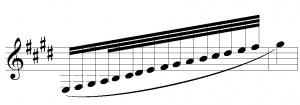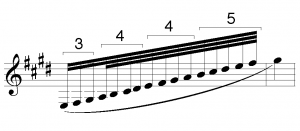Fast Scale Gestures and Grouping
The Villa Lobos preludes have been part of my new repertoire for this semester, and, while practicing the second one, something stuck out about fast scales. Especially those scales which are clearly gestural and “out of time”.
The challenge with any fast gesture is figuring out how to group the notes. In other words, determining how you are going to count and think about the thing in a way that makes sense.
Enter Grouping
There’s a really extensive book on note grouping and playing expressively that can be summed up in a few works: thinking of notes in groups, rather than individual dots on a page can help you be more expressive. The book, of course, gives a lot of specific examples from famous performers’ grouping.
The same sort of thing can apply to gestural, out of time passages in music. This sort of thing can be useful for eingänge in 19C music (think of them as mini-cadenzas usually found between big sections of a piece). And for that one scale gesture in Villa Lobos’ second prelude, as shown below. You can take a look at pieces by Brouwer for examples of where a composer has done grouping for you. Nearly every time he includes a fast gesture (such as in the first Preludio Epigrammaticos around 45 seconds in), Brouwer is very precise about the rhythms and how you should think about it. In the Preludio example, it’s 4 + 4 + 5.
The idea is you take a big gesture, and break it into little pieces. So a 16 note gesture could be 4 notes+4 notes+4 notes+4 notes or 3+4+4+5 or 3+3+4+6, etc.
A Look at Villa Lobos
This scale gesture is meant to fit into the space of a beat, however, the strong cadence before it (not shown) and the fact that it’s leading into a recap of the first material suggests you can probably take your time with it (it’s “out of time”). The fact that the note values get smaller suggests that perhaps Villa Lobos desires a little bit of a speed up. So here’s how I would think about it: in groups of 3 + 4 + 4 + 5.
Doing so gives me a way to count the scale and thus a way to practice it (with chaining and slow fast alternation). I think it also provides a little bit clear sense of direction than playing it as fast as possible.
Why 3+4+4+5? It helps reinforce the speed up I want towards the end of the scale. Even without changing tempo there’s an automatic speed up built in with the last quintuplet.
Is This the Only Way?
Of course not. I can only explain how I thought about that particular scale — what worked for me. Chances are some of you will like it and some will not. That’s okay.
What you should take away from this post is a way of thinking about fast, gestural passages in music (stuff that’s “out of time”). Grouping is a great way to get a handle on practicing and interpreting those passages.
PS: if you don’t own the Heitor Villa-Lobos Collected Works for Solo Guitar book, it’s worth picking up. Should be part of your music library, but you’ll probably have to change the binding.



Larry Deack
Gestural grouping is a fundamental property of music. Your example is not complete until you get rid of the 3-4-4-5 grouping and make it one gesture. The bottom of figure starts slow then steadily speeds up to the top in a smooth gradient not as a series of steps. Learning to hear this curve BEFORE you play it is critical but if you practice it as 3-4-4-5 you will reinforce that grouping rather than the natural gesture you would think of without analyzing it.
Capricho Arabe has the infamous chromatic run that is a similar gesture and can suffer from the same problem if practiced as bits stuck together.
Most gestures are curves shaped by tempo, volume and tone. There are a number of other examples which would be best practiced as gradients using these three elements. I strongly suggest this kind of practice to get precise control of the exact curve you want, and it is a curve and not a set line segments.
jj
Hmmm… “playing out of time”.
Often times people with limited technique, or problems of control, use it to mask their inabilities; by justifying their playing with phrases such as “playing expressively”, or “out of time”.
So one should watch out that one doesn’t end up distorting the composer’s message into something that, is closer to the utterances of drunk people.